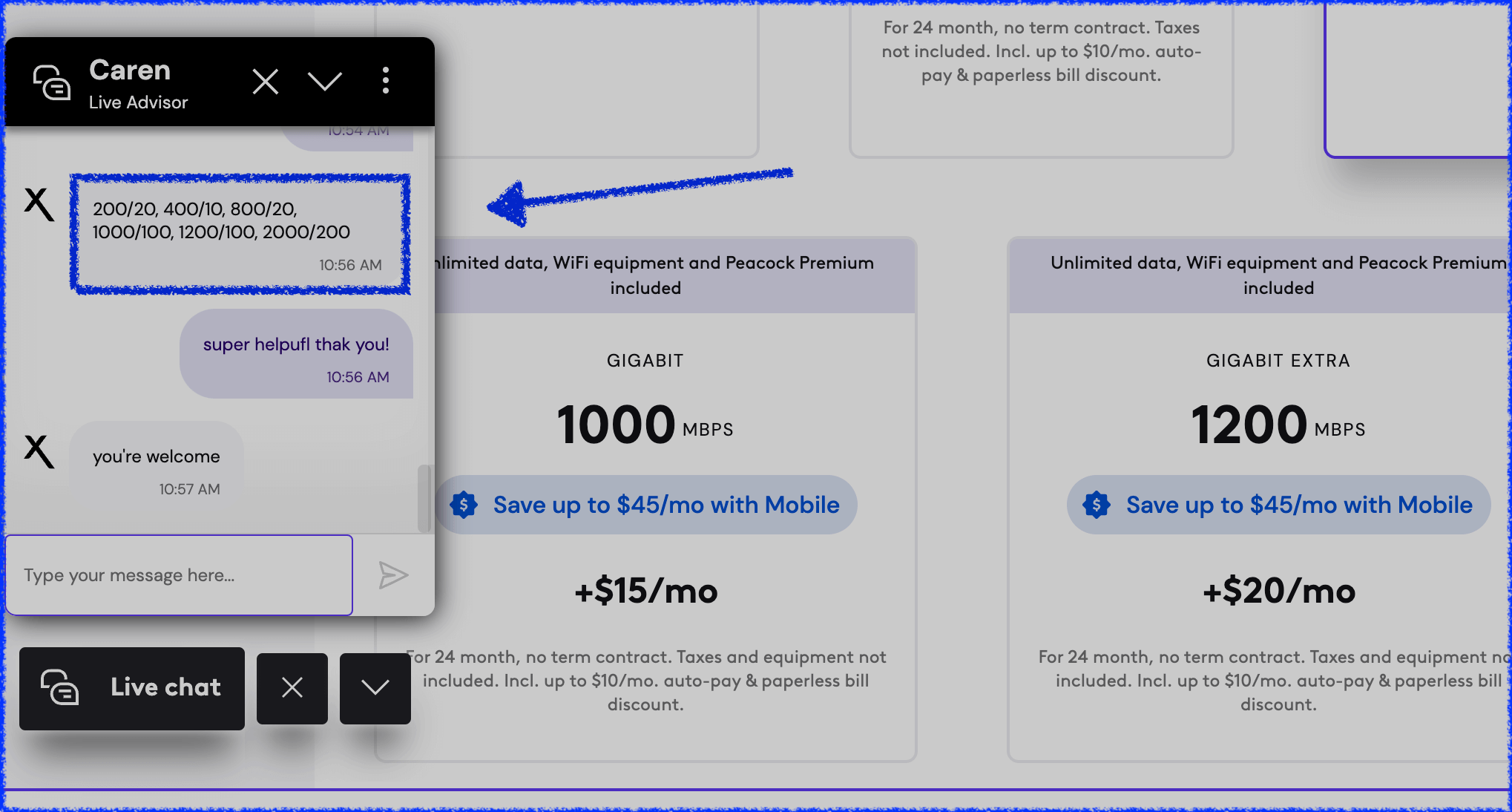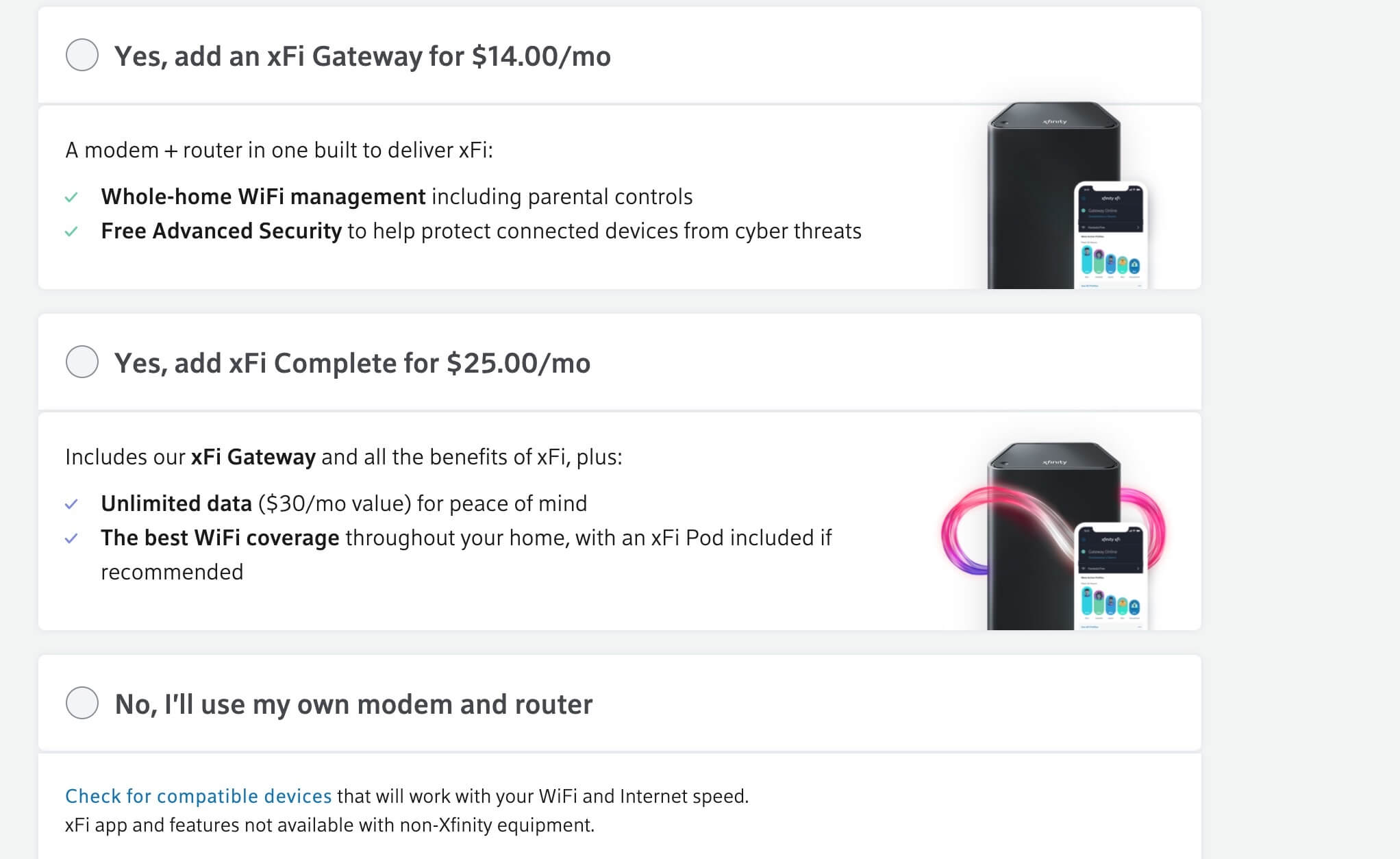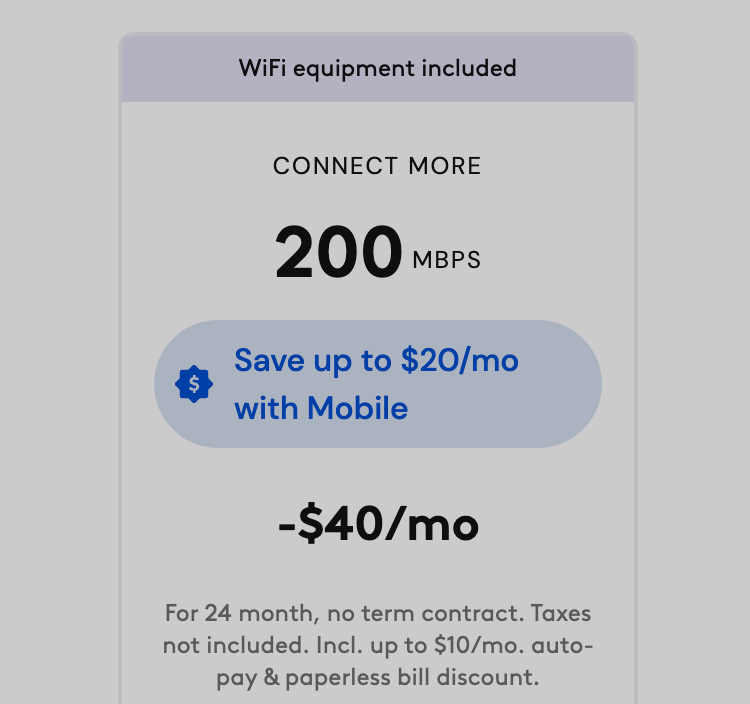After 12 months Xfinity upload speeds Plan fees Is Gigabit worth it? Xfinity Senior Discounts
As of 2024, Xfinity markets seven internet-only deals throughout their coverage area. Pricing for the cheapest plans starts at $19.99/month, then goes up to $57 + Wi-Fi equipment fees ($15–25) after the first 12 months.
Xfinity has raised their download speeds to a max of 2,000 Mbps in 2024, but the upload speeds are still capped at a maximum of 20 Mbps on all plans below Gigabit. The base plan still has a low 5 Mbps upload speed, which can be frustrating for families and home office users.
Xfinity Fast is the best internet-only plan for most homes, but not because of the 200 Mbps download speed.
We suggest Fast because it's the best price for a 20+ Mbps upload speed. This is 4X the base speed and easily worth it if you have more than two people at home using the connection for work, school, and entertainment.
Homes with more than two people usually need at least 10–15 Mbps upload speed to account for shared video chat use, particularly if anyone is working from home or remote learning.
Reduced price: Connect currently features free Wi-Fi equipment for the first two years in most regions, bringing the price down by $15/month. Check your address here to see if you qualify:
View Connect discountsXfinity Plan Uploads
One aspect of Xfinity pricing that can be frustrating is that the upload speeds aren’t always clearly listed. In fact, when compiling this page, I had to go through multiple Xfinity sales and chat agents to get a verified list:

The short version is: they’re much lower than the download speeds. This is standard for cable systems, since they are designed for home users who mostly download content and need relatively little upload in comparison.
On the bright side, the company made good on their promise to upgrade speeds from 35 Mbps to 200 Mbps by 2024.1
Still, it can come as a surprise when the download speeds have improved so much relative to upload over the past few years.
Xfinity cable plans go all the way up to 2,000 Mbps for download speed. However, because they are a hybrid fiber-coaxial connection rather than pure Fiber-to-the-Home, the maximum upload is just 200 Mbps.
The lower-cost plans that most customers actually buy are even lower at only 10–20 Mbps. For reference, that’s just enough to support one, maybe two 4K video streams, before you factor in multiple users, WiFi fade, etc.
| Plan Name | Download | Upload | Promo Price | Final Price |
|---|---|---|---|---|
| Connect | 75 Mbps | 5 Mbps | $19.99/mo | $57 |
| Connect More | 200 Mbps | 20 Mbps | $30/mo | $69 |
| Fast | 400 Mbps | 10 Mbps | $50/mo | $79 |
| Superfast | 800 Mbps | 20 Mbps | $60/mo | $89 |
| Gigabit | 1000 Mbps | 100 Mbps | $65/mo | $99 |
| Gigabit Extra | 1200 Mbps | 100 Mbps | $70/mo | $109 |
| Gigabit X2 | 2000 Mbps | 200 Mbps | $120/mo | $120 |
Cable speeds are designed this way because most users will make heavy use of download for video content. It wasn’t until post-Covid that working from home and remote culture went mainstream and made the need for more upload speed clear.
Unfortunately, most Xfinity plans are in the 5–15 Mbps range for uploads. It’s enough to support video calls but can be challenging for heavier use, such as multiple users relying on upstream bandwidth or backing up large files to the cloud.
If you want 200 Mbps uploads, your only choice is their most expensive “Gigabit X2” plan, which has 2,000 Mbps downloads and 200 Mbps uploads.
The only way to get faster than 200 Mbps upload with Xfinity is to try and get their custom-install fiber plan, Gigabit Pro. However, this costs $300+ per month and a $1,000 one-time install fee, not to mention several site survey and install visits.
If you’re curious to learn about “Pro” plan, there’s a great write-up about the application process for network engineers here, or you can check out my Xfinity Gigabit vs Gigabit Pro comparison.
Xfinity plan fees and fine print
Key point: factor in the equipment fees
The biggest caveat with Xfinity service in 2024 is the Wi-Fi equipment fees.
They've upgraded their equipment to feature two options: a $15/month "xFi Gateway" router and a $25/month "xFi Complete" package. This is five times the price charged by other cable companies like Spectrum for equivalent equipment.
Their justification for the price is that the xFi Complete system includes unlimited data. This is frankly frustrating, when their biggest competitor AT&T Fiber doesn't levy data caps at all — let alone charge by the gig.
To make matters even more complex, Xfinity includes the xFi routers at free or reduced rates for some plans, which can result in the same final bill amount for seemingly different plans like “Connect More” and “Fast.”
…Until the discount expires in your second or third year of service, causing a $15–25 per month bill increase.
While it is possible to negotiate Xfinity deals for existing customers, the process is time-consuming and it’s not usually possible to get the full discount returned.
Xfinity WiFi router options
Xfinity comes with three router options in 2024:
- xFi Gateway
- xFi Gateway Complete
- Bring your own
| WiFi option | Monthly fee | Hardware | Features |
|---|---|---|---|
| xFi Gateway | $15 | xFi Gateway (modem/router combo device) | WiFi |
| xFi Complete | $25 | xFi Gateway, xFi Pod, unlimited data | WiFi |
| Own Router option | No charge | Bring your own modem and router | Voids tech support |
The xFi Gateway is basically a modem/router unit that broadcasts WiFi in your home. The upsell for “complete” throws in an xFi Pod (basically a WiFi extender, or mesh WiFi device) that extends the WiFi for larger or oddly-shaped homes. xFi complete also includes unlimited data.
The xFi Pods are made in collaboration with a company called Plume, which is a good thing because they’ve been doing some of the more interesting work improving home networking hardware/software in the past couple years.
Xfinity is their largest partner, but they also work with a variety of smaller ISPs.

$15 per month is pretty steep for WiFi service, although Xfinity makes a case for it with decent hardware and well-designed mesh networking options. However, if you’re in a two-bedroom home or apartment, you’re likely better off just buying your own to save the $180–300 per year it adds up to.
Xfinity is compatable with most major modem and router combinations, and they maintain a full list of compatable devices on their site.
I’ve written up a full guide on how to remove the Xfinity Wi-Fi fees here.
I’ve also written up a guide on how to handle common tech support issues with the xFi Gateways, such as when the Xfinity router light turns red during service interruptions.
Xfinity Plans for Low-Income Households
Low-income households can access Xfinity's reduced-cost basic service plans. These plans provide reduced speeds for a lower $9.95 monthly price, with no WiFi router fees.
Note that this plan cannot access the faster 200 Mbps speed tier; this is reserved for full-price customers.
| Plan Name | Speed Down/Up | Monthly Price | WiFi Fee |
|---|---|---|---|
| Xfinity Internet Essentials | 50/10 Mbps | $9.95/mo | $0/mo |
| Xfinity Internet Essentials Plus | 100/20 Mbps | $29.95/mo | $0/mo |
Among all low-income internet programs in California, Xfinity's has the best price-to-speed ratio. The only other providers at the $10 price point are Cox and AT&T. Neither matches the 50 Mbps download speed for low-income customers.
They are also the only provider I’ve seen that offers specific debt amnesty options to low-income households. Customers who meet certain income qualifications and have old debt with Comcast can still get low-income services using this program, among other payment extension and arrangement options.
Xfinity deals by market
Xfinity deals in San Francisco Bay Area Xfinity deals in Sacramento
Frequently Asked Questions
How much is Xfinity internet only service?
The introductory price of Xfinity internet only service ranges from $19.99 per month for base plans up to $103 for the premium Gigabit Extra plan. Wi-Fi router leases typically increase the price $15–25 per month. After the first year, new customer discounts no longer apply, causing an additional $18–31 per month bill increase.
What is the Xfinity upload speed?
Xfinity cable plans have a maximum upload speed of 35 Mbps. Base plans have lower uploads, ranging from 5 Mbps on the entry plan up to 10–20 Mbps for their mid-tier plans.






